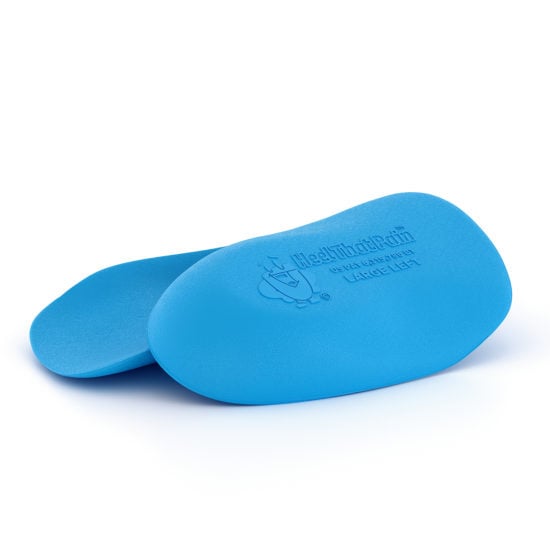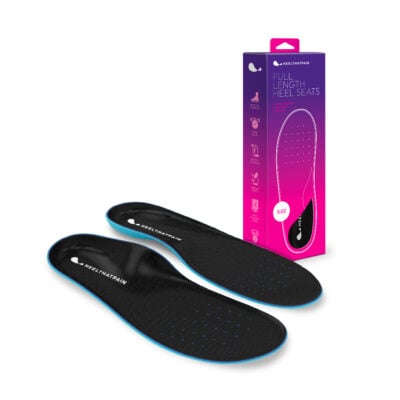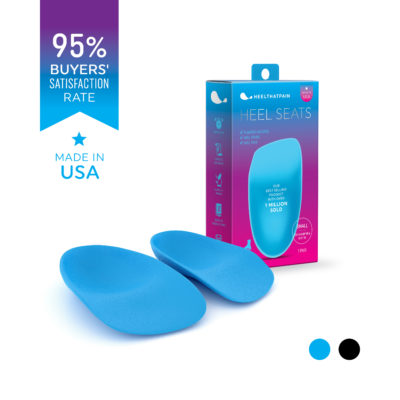Does Strength Training Help or Hurt Plantar Fasciitis?
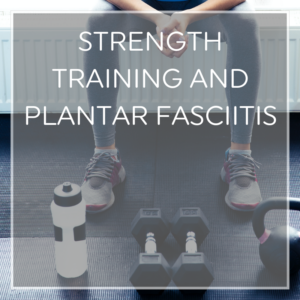 Most people who take part in strength training programs like Crossfit or BodyPump are typically very dedicated to health and fitness.
Most people who take part in strength training programs like Crossfit or BodyPump are typically very dedicated to health and fitness.
And while high-impact strength training can have incredible cardiovascular and muscle-building benefits, they can be extremely hard on the joints, fascia, and ligaments in the hands, arms, legs, and feet.
If you love staying fit with strength training — but wonder if you should worry about heel or arch pain, keep reading!
Plantar Fasciitis and Strength Training
While it’s true that strength training can put a lot of strain and impact on different muscle groups, ligaments and fascia (including the plantar fascia in the foot!) a lot of the outcome depends on your unique body, the exercises you participate in, and how well you care for your body when you’re not strength training (e.g., through a proper warmup and cool down good nutrition, and adequate rest between workouts).
While there are plenty of athletes who do suffer from plantar fasciitis as a result of strength training, there’s also some evidence that strength training programs can actually help improve plantar fasciitis, like this report from the Scandinavian Journal of Medicine and Science in Sports. The study followed participants who wore orthotic inserts and performed mild stretching daily, versus participants who wore orthotic inserts and engaged in high-load strength training daily. At the end of the study, the participants who engaged in strength training reported better function and pain levels.
Can Programs Like Crossfit Cause Plantar Fasciitis?

There’s no straightforward answer here: Many individuals who regularly enjoy Crossfit or BodyPump will maintain healthy arches and pain-free heels. Depending on the type of program and the types of exercises, some people may even enjoy protection from and improvement of heel pain or arch pain!
However, most types of strength training can still pose some risk of plantar fasciitis and heel pain. Specific high-impact exercises or routines that place a lot of strain and force on the arch of the foot through running, jumping, and lifting weights, strength training can be risk factors for heel pain.
Remember: Any high-impact activity, including jogging, basketball, or even standing in place for long periods of time can increase your risk for plantar fasciitis. The important thing is to take heel pain seriously, treat it quickly with effective remedies, and approach strength training in such a way that your heels and arches stay healthy!
Strength Training Safely for Plantar Fasciitis
If you love strength training, there are plenty of ways you can enjoy your passion safely–even if you have plantar fasciitis! This strength training protocol, originally developed by Dr. Rathleff, can be incorporated into your routine to help protect against plantar fasciitis or improve existing heel pain.
If you do notice heel pain while strength training, listen to your body. Take a break from the specific exercises or activities that aggravate the pain, and use the simple, inexpensive treatments below to give your arches extra support and cushioning.
If you’re taking a group fitness class like Crossfit, let your instructor know what’s going on. He or she can help you make modifications for very high-impact exercises that do not include a lot of jumping or strain on the heels, arches, or feet.
Are There Any Exercises I Should Avoid?
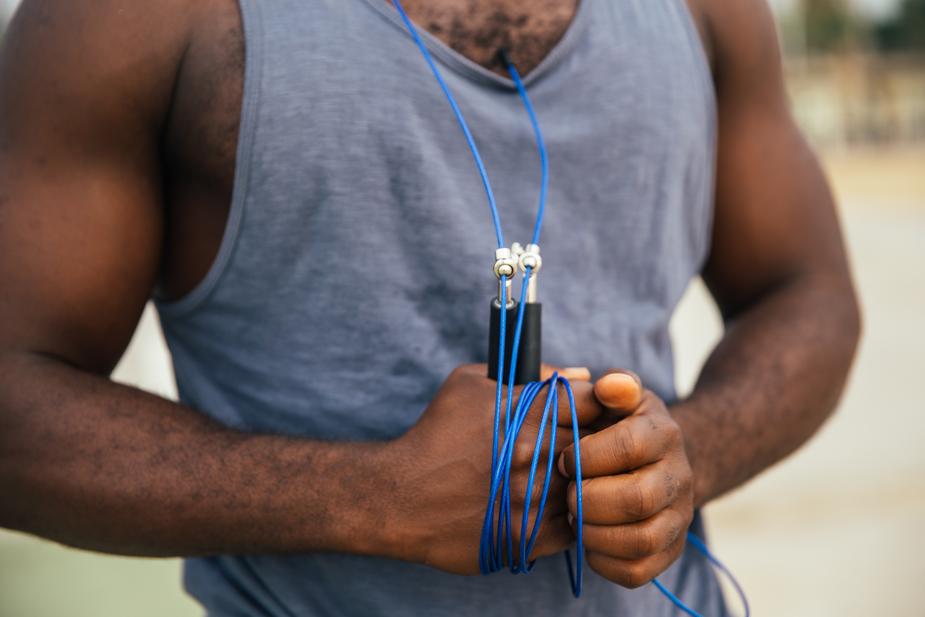
Again, the answer to this question depends a great deal on the health and strength of your feet and heels. If you’re new to strength training, acclimate to working out slowly, and allow yourself a couple days of rest between workouts to avoid degeneration and micro-injuries that may cause pain and lead to plantar fasciitis.
If you are experiencing heel pain while you strength train, you may want to avoid plyometric exercises (where both of your feet leave the ground) until you’re fully recovered. These exercises can include full-jacks and hal- jacks, long jumps, squat jumps, froggy jumps, jumping side lunges, jogging in place or running sprints across the room, and jumping rope.
In general, if your symptoms are mild, it’s okay to continue lifting weights, participating in low-impact exercises, and continuing exercises that strengthen the legs, feet, and ankles. Make sure you support your plantar fascia with orthotic inserts and use the treatments below to manage and treat your heel pain. When in doubt, see a doctor, especially if your pain is severe and you suspect you may have sustained a fracture or tear.
Treating Heel Pain from Strength Training
For most people, rest is a good first-line defense against heel pain from strength training. If particular activities seem to make your heel pain worse, avoid them until you feel better, then continue paying attention to how your body feels as you run, jump, or lift weights.
Icing, NSAIDs like Ibuprofen, and Tylenol can help bring down inflammation and manage pain flare-ups while taping and compression socks can help reduce swelling and improve blood flow while you exercise. Remember to warm up and cool down properly with stretches that strengthen and improve flexibility in your arch, calves, toes, and ankles.
To help your arch absorb extra impact and weight while you strength train, slip Heel Seats (an orthotic insert proven twice as effective as Dr. Scholls) into your favorite pair of supportive athletic shoes.
As you listen to your body, respond to heel pain quickly, and approach strength training safely, you can enjoy all the health benefits you set out for–including healthy feet, heels, and arches!
Is Plantar Fasciitis a Disability?
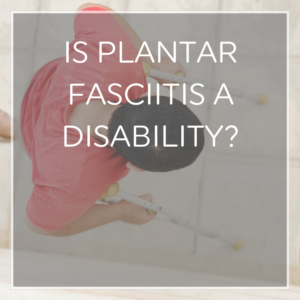 The answer to this question depends a lot on context. A disability can be medical–an injury or a limitation that affects how you live your life. Or a disability can be a legal classification that determines whether or not you’re able to receive different benefits (like Social Security disability benefits, or Veterans Administration benefits).
The answer to this question depends a lot on context. A disability can be medical–an injury or a limitation that affects how you live your life. Or a disability can be a legal classification that determines whether or not you’re able to receive different benefits (like Social Security disability benefits, or Veterans Administration benefits).
Plantar fasciitis can be both a medical disability and a legally-protected disability that may qualify you for medical treatment, insurance coverage, or disability benefits, depending on a few different factors. In this post, we’ll explore what qualifies plantar fasciitis as a legal disability, how plantar fasciitis disabilities are classified, and whether plantar fasciitis qualifies for VA disability.
What Qualifies Plantar Fasciitis as a Disability?
In the United States, the Americans with Disabilities Act (or ADA) defines the word “disability” in a legal sense, as a mental or physical condition that “Substantially limits one or more major life activity. This includes people who have a record of such an impairment, even if they do not currently have a disability. It also includes individuals who do not have a disability but are regarded as having a disability.”
Whether or not your plantar fasciitis qualifies as a disability in the legal sense or not, your pain and suffering are real. Heel pain and plantar fasciitis can be extremely debilitating, making it difficult to walk or participate in daily activities. Talk to your doctor about whether you may be eligible to get a Handicapped Parking Permit
Plantar Fasciitis can be considered a legal disability that qualifies you for Social Security disability benefits in the US under these conditions:
- You have severe plantar fasciitis that makes it difficult or impossible for you to work — and you can show that your particular job is difficult or impossible to perform with plantar fasciitis
- You can document that your plantar fasciitis has significantly interfered with or prevented you from working your work for at least a year–or would prevent you from working for at least a year.
- Your plantar fasciitis has been officially diagnosed and documented by a licensed doctor
- If you’re over age 50, your claim for benefits may be approved more quickly
If you believe that your plantar fasciitis may be considered a legal disability, you should talk to your doctor, then apply for disability benefits with the Social Security disability office. It’s important for you to keep records of all your doctor’s visits, work you’ve had to miss, or any other records that show how much plantar fasciitis has impacted your life. It’s also important to understand that the process of obtaining benefits can take some time, and some paperwork!
In countries outside of the US that use socialized medicine, obtaining disability may be less difficult, and you may qualify for benefits whether or not you are working. In the UK, the disability must be present (or seem likely to continue) for 9 months instead of one year. To find out whether or not you qualify for disability benefits outside of the United States, start by contacting your local branch of government to get the ball rolling.
How Is Plantar Fasciitis Classified as a Disability?

There isn’t a straightforward path for classifying plantar fasciitis as a disability in the Social Security’s Bluebook, which is a list of conditions and impairments that might qualify you for benefits.
Depending on your unique situation and the location of any heel spurs, you may be able to get SSA benefits under Section 1.02, Dysfunction of a Joint.
However, most people with plantar fasciitis end up qualifying for benefits under Social Security’s “RFC” (residual functional capacity) clause, an assessment that determines how severe your pain is, and how much it interferes with your ability to work.
In an RFC assessment, disability claims employees will perform an assessment to look at your limitations, your doctor’s documentation of which treatments you have tried, how long you’ve been suffering from plantar fasciitis, how the pain affects your daily life, and any medications you’re using. Keep in mind that, in general, the claims assessment is mostly a process of reading through documents. Some claims fail because a doctor didn’t fully and completely describe pain levels and intensity, or document just how much the condition impacts your life on a daily basis. Make sure you communicate with your doctor about this process, and how important thorough documentation is for your case.
Does Plantar Fasciitis Qualify for VA Disability?
VA disability assistance helps veterans who have served the United States recoup medical expenses for injuries they’ve sustained during military service or because of military service.
Many vets suffer from painful heels and feet from plantar fasciitis, which can make walking, moving, or living life difficult. The VA may also approve claims for depression caused by the pain from chronic plantar fasciitis, foot deformities that lead to the collapse of the arch, sciatica, or back and knee problems that are related to plantar fasciitis.
Depending on how severe your pain and disability from plantar fasciitis is, the VA benefit will rank your condition on a scale from 10-100 (with 100 being the most severe and eligible for the most benefits).
Similar to the SSA, a VA disability claim for plantar fasciitis will need to be submitted to the VA and evaluated, so the more you and your doctor can document your condition, treatments, and your pain level the better your chances of receiving appropriate benefits.
The pain from plantar fasciitis can be truly debilitating–and disabling–especially when the condition is chronic. Whether or not your unique situation qualifies for disability benefits with the SSA or VA, you deserve support and relief from family, friends, and other plantar fasciitis sufferers. And if you do decide to pursue disability benefits for your condition, remember to document your pain and your treatment process as thoroughly as possible, work together with your health provider to help them understand the types of details you need to document, and follow the claims submission and review steps outlined by the SSA or the VA to get the financial help you need.
Osteopathic Manipulative Treatment (OMT) for Plantar Fasciitis
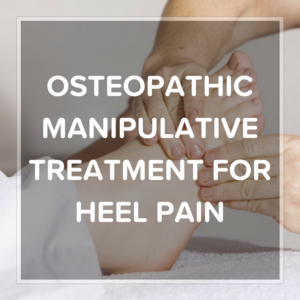 Osteopathic Manipulative Treatment (OMT for short) is a treatment for Plantar Fasciitis that involves manipulating the bones and connective tissues in the foot to help them align properly, bear weight more effectively, and work correctly in tandem with the arch of your foot.
Osteopathic Manipulative Treatment (OMT for short) is a treatment for Plantar Fasciitis that involves manipulating the bones and connective tissues in the foot to help them align properly, bear weight more effectively, and work correctly in tandem with the arch of your foot.
This noninvasive treatment is usually performed by an osteopath, a doctor who specializes in holistic (whole-body) medicine and musculoskeletal problems. Osteopathic doctors typically emphasize noninvasive treatment options and proper alignment as the basis for healing.
What is OMT, what are the pros and cons of this type of treatment, how much does it cost, and where can you find a provider for this treatment?
What is OMT?
OMT, or Osteopathic Manipulative Treatment is a type of physical therapy for Plantar Fasciitis that helps realign the bones and soft tissues in the foot.
Unlike some treatments, OMT takes a whole-body, holistic approach to healing. In other words, while your osteopath will gently manipulate your foot bones and tissues, he or she will also look at the alignment of your ankles, legs, and hips.
Robert Truax, DO, says. “For [pain from plantar fasciitis] the evaluation and treatment both begin with the hips. I evaluate the lower back and pelvic areas because the foot lands where the hips tell it to. If there is tightness or restriction in the hips, the foot lands incorrectly, setting up abnormal stress loads that can result in pain.”
During each treatment session, your doctor will apply gentle pressure, targeted stretches, some elements of massage, and other exercises to encourage the bones, muscles, and ligaments to align properly. You can also expect to be given “homework” in the form of additional exercises and stretches, rest and icing, taping, and wearing orthotic insoles to help stabilize gait, support the arch, and align the posture properly.
Pros and Cons of Osteopathic Manipulative Treatment
While OMT isn’t backed by a lot of evidence, the pros outweigh the cons for many people with plantar fasciitis:
Pros of Osteopathic Manipulative Treatment
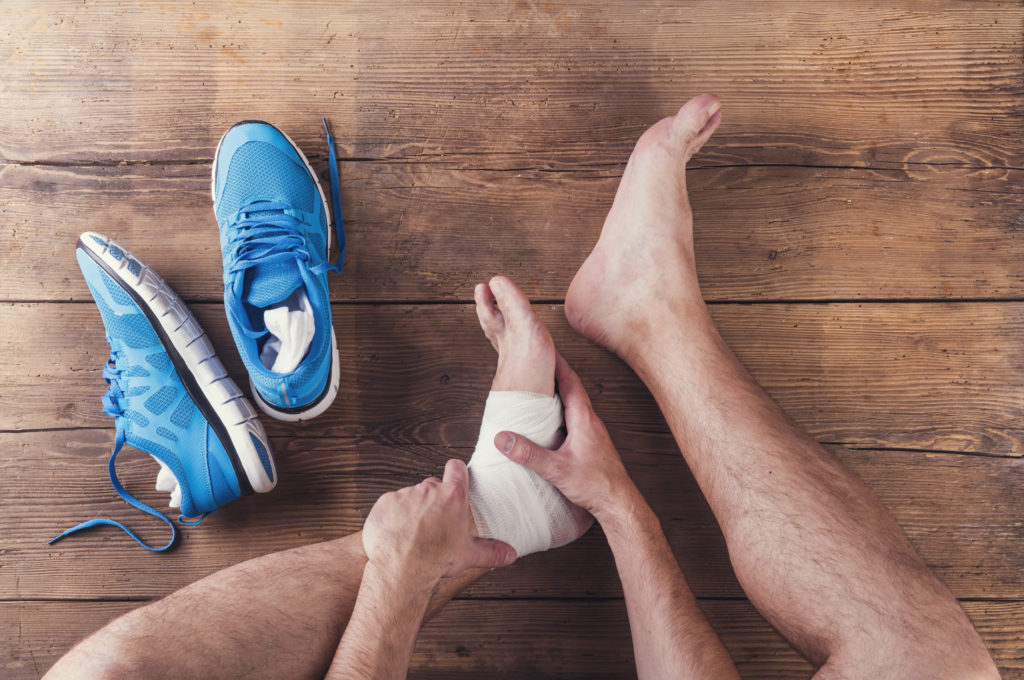
In general, OMT has very few risks, and uses many different techniques that are supported by solid evidence (like stretching and orthotics!)
Noninvasive and Painless
OMT doesn’t involve incisions, surgical instruments, or expensive equipment. The experience is painless and totally noninvasive.
Relatively Inexpensive
While costs of OMT can vary depending on your provider and whether the treatment is covered by insurance, most people end up paying somewhere in the neighborhood of $100 per session, a small cost in comparison with many treatments. Some osteopathic doctors offer discounts for booking several sessions at once.
Significant Anecdotal Evidence, and Proven Techniques
While OMT doesn’t have the distinction of many scientific studies or clinical trials, it does incorporate a lot of proven conservative treatments for plantar fasciitis, including stretching, icing, massage, and the use of orthotics.
OMT also has plenty of anecdotal evidence to back it up, from people who have had success with an osteopathic doctor. If you’re considering OMT, it can be helpful to talk to real people who have had this type of treatment.
Whole-Body Focus
Plantar fasciitis usually develops as a result of multiple factors and multiple body systems (like excess body weight combined with improper gait, combined with overuse in exercise). It only makes sense that a whole-body approach to plantar fasciitis that takes into account gait, alignment, posture, and musculoskeletal health along with biomechanics in the foot, ankle, hips, and legs would be very helpful in healing.
Cons of Osteopathic Manipulative Treatment
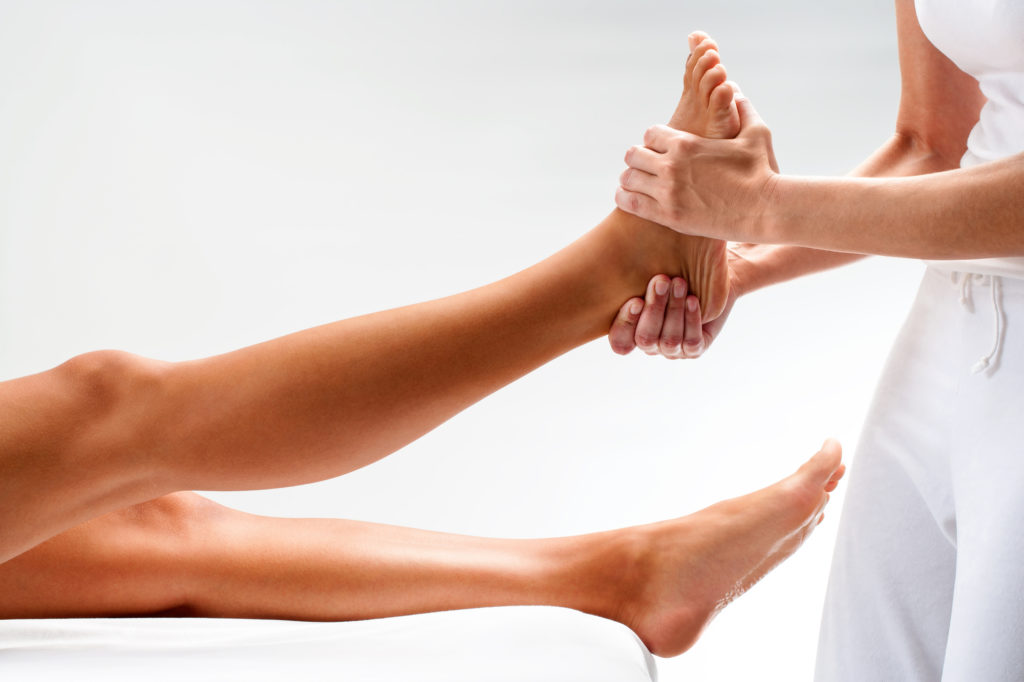
OMT doesn’t have a lot of evidence to back it up, which is the primary con. You should also take care that your provider uses non-thrusting techniques, which have the potential to damage bones and tissues.
Minimal Clinical Evidence
A review of OMT-related studies conducted by Warwick Medical School showed that more evidence, and higher-quality studies are needed to make any definite conclusions about osteopathic manipulative treatment.
However, this doesn’t mean this treatment is ineffective–it just means OMT hasn’t been proven effective. It just means that you should proceed with caution before investing a lot of money or time into this procedure. Given the minimal risks and side effects from OMT, many people feel that this treatment is worth a try–and many have had significant success!
Caution with Thrusting Techniques
Thrust techniques aren’t usually part of plantar fasciitis treatments; however, these more abrupt, forceful movements can carry a higher risk of trauma or complications, so talk to your osteopath before your treatment to ask about what techniques will be used, and whether your OMT will be low or high velocity, and thrusting or non-thrusting.
Where Can I Get OMT?
You’ll need to find a DO, or doctor of osteopathy to get OMT treatment. You can find a DO in your area on osteopathic.org. Make sure to ask the osteopath you choose whether or not they offer this treatment, since some practitioners may not offer certain treatments.
In case you’re wondering, an osteopath has completed four years of medical school, and many have additional medical training. Your osteopath will be able to help you with OMT, and is also fully authorized to prescribe and perform other medical interventions and prescribe medications.
Is OMT right for you? For many people with heel pain from plantar fasciitis, the answer is a resounding yes. And while this modality doesn’t have a lot of high quality studies or evidence backing it up, that just makes it extra important to do your research, know what to expect, and proceed with caution while continuing proven conservative treatments for plantar fasciitis like orthotics, stretching, icing, and rest.
How to Correct Posture from the Feet Up

Posture communicates plenty–but what posture communicates about your health is one of the most important things you should be aware of. Because it turns out that when your mom told you to sit up straight, she was on the right track. However, science tell us that when it comes to posture, she should have been just as worried about your feet!
Why? Keep reading!
Posture Basics, Head to Toe
Poor posture–hunching, sunken shoulders, and a slumped back–can have a dramatic effect on your muscles and ligaments. It can lead to injuries of the knees, heels, feet, back, and even difficulty with breathing and digestion. Bad posture is typically caused by–and exacerbated by–an imbalance in your muscles in strength and tension, and the muscles in your feet play a critical role. For example, tight calf muscles paired with weak plantar fascia can wreak havoc on your gait and foot posture (the alignment of the foot itself). This poor posture is a vicious cycle, causing the body (which naturally leans slightly forward) to tilt further forward or backward, adding additional strain to your feet and heels, and making plantar fasciitis–and posture–worse.
Postural Benefits of Wearing Orthotics
Wearing orthotics can have a tremendous positive impact on good posture, since the way the feet absorb and distribute impact has a big effect on the rest of the body. While orthotics are often seen as just a solution for heel pain, they can also be used as simple at-home solution to improve posture in the following ways:
Correct Gait Abnormalities
Your feet are your foundation every time you run, walk, jump, or stand. The impact from these simple daily activities, combined with the weight of the human body can place a great deal of strain on the heel and arch of the foot. Over time, as the body tries to compensate for this strain and pain, gait abnormalities can develop that result in poor posture.
Improve Balance
Since orthotics help lift the arch to an optimal height and cushion the heel, the feet (and therefore the ankles, legs, hips, etc.) are more balanced, helping you avoid stumbles and falls that can injure or throw any number of the body’s muscle groups, bones, or tissues out of alignment and creating poor posture.
Reduce Pronation
Pronation is where your foot turns too far inward as you step forward, causing the arch to flatten excessively. Pronation is associated with increased incidences of plantar fasciitis, heel pain, gait abnormalities–and poor posture. Orthotics can help correct overpronation while you walk.
Distribute Weight and Impact More Effectively
Because orthotics cushion and support the arch, you’re able to more effectively distribute and bear the weight of walking, running, and jumping. And when your arch is able to do its job in absorbing impact effectively, you’ll feel less aches and strain to your hips, back, and legs.
What to Look for in Orthotics to Improve Posture
There are a lot of different orthotics to choose from on the market. If you’re looking to improve your posture, you’ll want to keep an eye out for the following qualities:
Lightweight: Heavy orthotic shoes can negate some of the positive postural effects of using orthotics in the first place, and don’t allow for much flexibility in rotating between different pairs of shoes. Look for lightweight orthotic inserts that can be added to any pair of shoes.
Cost effective: There’s not much evidence that expensive prescription orthotics are any more effective than inexpensive orthotic inserts (some of which are more than 90% effectivein treating heel pain and plantar fasciitis!) Balance quality with cost!
Cushioning and Supportive: The perfect blend of support and cushioning can be surprisingly hard to find. If you can crush your orthotic insert in your hand, it’s not likely to stand up very well to the rigors of walking, running, or jumping. Make sure your chosen orthotic is sturdy enough to stand up to some pressure while still providing cushioning for your heel and arch.
Fascia Bar Technology: This patented technology brings the arch to the optimal height for support and comfort during physical activity. This innovative technology helps the arch tremendously with weight distribution and impact absorption.
Other Ways to Improve Posture
Another great way to improve your posture from the feet up is by using simple stretches to make sure that your muscles and tendons are limber and not too tight. Taking a few minutes every day to stretch your calves, fascia, and other muscles and tendons in the feet and legs can make a world of difference. When your muscles are limber and stretched, you’ll avoid a situation where one group of muscles is pulling another forward or backward subtly, throwing off your stride–literally.

Proper stretching and properly supporting the feet and heels help ensure that your weight falls on the balls of your feet first as you walk–instead of your heel. With a heel-first gait (caused and exacerbated by bad posture), your feet absorb greater impact and aren’t able to propel the body forward as effectively–meaning you’re having to work extra hard to walk the same distance and putting additional strain on your fascia and heels.
Improving Foot Posture
As you work to improve your overall posture, make sure you don’t neglect the posture of your feet themselves. Improving overall posture is hard to do when your feet–which support the weight of your entire body–aren’t in the correct position!
Properly aligned feet should face forward, rather than one or both feet turning inward or outward. As you properly support your feet and stretch your calves, heels, and fascia, you should find that your feet align more properly and that physical activity becomes more comfortable as well. An additional method that can be taken to improve foot alignment if you’d like to see faster results is wearing a night splint that supports your feet and heels, and keeps the fascia limber even while you’re sleeping.
By correcting your posture from the feet up, not only will you look better–and communicate more confidence to the people around you–but you’ll feel better and avoid future injuries with a body in balance.
Evidence Based Treatments for Plantar Fasciitis
 There’s plenty of anecdotal evidence for most Plantar Fasciitis treatments. Everyone has a cousin or friend of a friend who swears by a particular way of banishing heel pain.
There’s plenty of anecdotal evidence for most Plantar Fasciitis treatments. Everyone has a cousin or friend of a friend who swears by a particular way of banishing heel pain.
But what does the evidence say?
While anecdotes and recommendations from friends and family shouldn’t be discounted–especially if the treatment is affordable and low risk–it’s also important to know how different treatments stack up in clinical studies and peer-reviewed journals. Looking at this evidence, alongside recommendations from people you know and love, can help you make the best decision for your foot health and healing.
Evidence-Based Plantar Fasciitis Treatments
In this article, we’ll review some of the treatments for Plantar Fasciitis and heel pain that are backed by the most high-quality evidence. Each of these treatments has been legitimized by rigorous double-blind, peer reviewed studies and documented by scientists, doctors, and podiatrists in journal articles and highly regarded publications.
Since expense and invasiveness are usually the biggest deciding factors in treatment options, we’ve divided these evidence-based treatments into inexpensive and noninvasive, moderately expensive and minimally invasive, and expensive and invasive categories.
Inexpensive, Non-Invasive Treatments Backed by Evidence
Surprisingly, some of the simplest, least expensive treatments for plantar fasciitis are also backed by the most evidence.
That’s why the overwhelming majority of podiatrists and doctors recommend trying these proven, effective treatments for heel pain before moving onto more expensive options. Numerous studies, including research published in American Family Physician, show than 90 percent of patients can resolve their Plantar Fasciitis using only noninvasive and conservative methods.
Orthotics
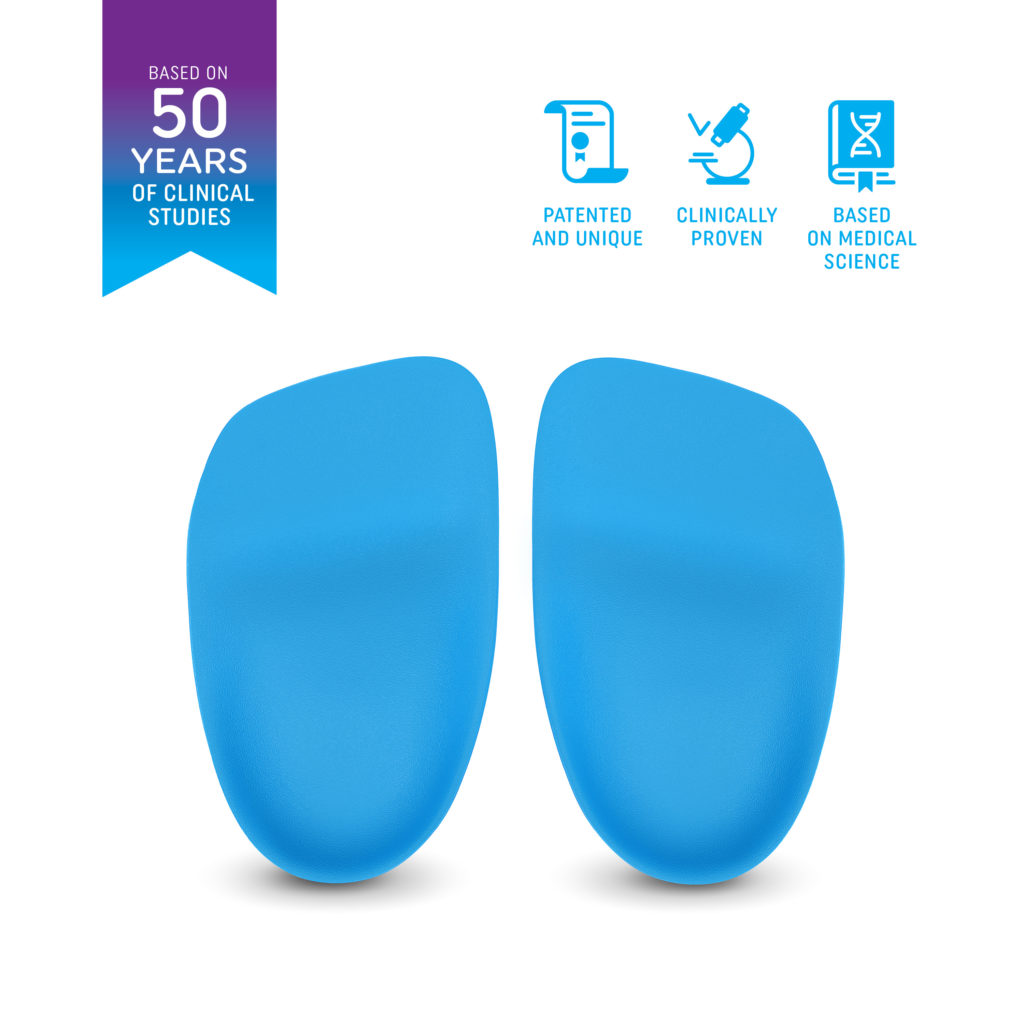
The effectiveness of orthotic inserts is heavily debated. But evidence like Blake and Denton’s review of orthotics’ effectiveness published in the Journal of the American Podiatric Medical Association show that orthotics generally have 70%-90% effectiveness. And this study published in the Journal of Foot and Ankle Research shows that even non-custom orthotics can reduce the load on a damaged arch by 34%.
It’s important to keep in mind that not all orthotics are created equal. A double-blind study conducted by the University of Iowa found that Heel Seats, with patented Fascia-Bar Technology, are twice as effective as a leading orthotic insert. Heel Seats lift and realign the plantar fascia, target pain with acupressure, and cushion the heel for pain relief.
Stretching and Massage
Dr. Emily N. Schwartz’s review of different plantar fasciitis treatments confirmed that stretching and massage are two of the most effective at-home treatments for plantar fasciitis.
Stretches that improve flexibility and strength in the arch, Achilles tendon, ankle, calf, and legs can help the arch and supporting systems bear weight properly, and distribute impact. Massage can help improve blood flow to the injured area as well as break up scar tissue and adhesions.
Taping and Splinting
Dr. Podolsky and Dr. Kalichman’s review of several clinical trials and studies showed that taping is an effective short-term treatment method plantar fasciitis. Taping helps relief pain, apply soothing pressure with a gentle stretch, and stabilize the arch.
Splinting, similar to taping, helps keep the foot flexed in a mild stretch to reduce the morning pain and stiffness that is common with plantar fasciitis. In one study published by Clinical Orthopaedics and Related Research, 68% of participants improved their plantar fasciitis pain by using a night splint. In other studies, participants have reported struggling to use night splints consistently because of the hard brace. In these situations, Sock Night Splints can be a softer, but still effective solution.
Icing
Icing is a tried-and-true technique for many different types of pain relief–not just plantar fasciitis! Researchers from the Department of Physical Therapy at Loma Linda University showed that cold therapy (icing) was very effective in relieving pain and even reducing the thickness of the plantar fascia (one of the telltale signs of plantar fasciitis!).
Moderately Expensive, Minimally Invasive Treatments Backed by Evidence
For about 10% of people, at-home treatments for Plantar Fasciitis are not effective. If conservative treatments aren’t working after 9 months to a year, it may be time to consider moderately expensive and minimally invasive treatments backed by evidence.
These treatments are generally less than $200 per treatment, depending on your insurance coverage, show a great deal of promise in studies and clinical trials, and require minimal downtime.
Radiation Therapy

Radiation therapy uses a very low dose of radiation (similar to an X-ray) to This therapy is also on the lower end of cost, has minimal side effects and risks, is simple and non-invasive, and is not painful.
A key study by Dr. Robert Michael Hermann, MD, showed that radiation therapy can be a very effective non-invasive treatment method for plantar fasciitis patients. A 2012 study by the American Society for Radiation Oncology confirmed that 80 percent of study participants reported complete pain relief after radiation therapy, and 64 percent were still pain free after 48 weeks.
Ultrasound Therapy
Ultrasound therapy uses sound waves to break up tissue, improve blood flow, and reduce inflammation in painful feet and heels. The procedure is easy, quick, and relatively painful.
Evidence from several studies shows that ultrasound therapy can improve heel pain by up to 90%, including a 2013-2014 study conducted by Advanced Medical Imaging that followed 65 patients with chronic plantar fasciitis who used ultrasound therapy.
Intracorporeal pneumatic shock therapy (IPST):
This newer therapy is inexpensive, minimally invasive, and shows a great deal of promise in treating Plantar Fasciitis. IPST uses a small probe that emits shock waves to break up heel spurs. It requires local anesthesia, but minimal downtime. One double-blind clinical study conducted by the medical faculty at Mustafa Kemal University showed a 92% success rate in pain reduction with IPST.
More Expensive Medical Interventions Backed by Evidence

These evidenced-based methods for treating plantar fasciitis can be very effective, but are usually only recommended after more conservative or less expensive methods have been exhausted, because of the recovery time and expense involved:
Topaz Surgery
Topaz Surgery, or Topaz Coblation therapy, uses a tiny wand to make a few dozen holes in a grid pattern over the plantar fascia. As these holes are made, the wand releases small amounts of radio wave energy to destroy and remove bits of tissue to break up scarring and encourage a healing response.
Either local anesthesia or sedation may be used. And while recovery time is much easier than surgery, a walking boot and orthotics should be used, and total recovery time takes 4-6 weeks.
Topaz surgery has been approved by the FDA since 2002, and a study by Department of Orthopaedic Surgery at Singapore General Hospital showed that Topaz is a very effective medical intervention for plantar fasciitis. A study published in Foot and Ankle Surgery in 2016 showed that Topaz has an 80% success rate (similar to traditional surgery).
Plantar Fasciitis Surgery
While surgery is a big decision, it can be a good choice for individuals whose heel pain is chronic or does not respond to conservative treatments. Studies conducted by doctors and researchers at the New Britain General Hospital and the Center for Orthopaedic Care, among many others show success rates of 80% to as high as 96%, with few complications.
While surgery does require more downtime and recovery time, the evidence is clear that this last-resort is generally extremely effective.
You have plenty of choices when it comes to how you will treat your heel pain. But the most important deciding factors in getting you back on your feet should be evidence of effectiveness combined with your own unique health needs!
Whether you’re able to resolve plantar fasciitis using conservative treatments like orthotics and stretching, or need to have plantar fasciitis surgery, the goal is the same: helping you walk, move, and enjoy life without pain.

